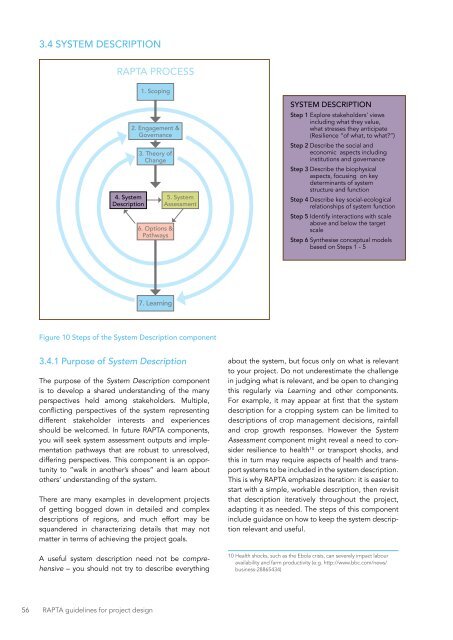DESIGNING PROJECTS IN A RAPIDLY CHANGING WORLD
srun3013fp1
srun3013fp1
Create successful ePaper yourself
Turn your PDF publications into a flip-book with our unique Google optimized e-Paper software.
3.4 SYSTEM DESCRIPTION<br />
RAPTA PROCESS<br />
1. Scoping<br />
4. System<br />
Description<br />
2. Engagement &<br />
Governance<br />
3. Theory of<br />
Change<br />
6. Options &<br />
Pathways<br />
5. System<br />
Assessment<br />
SYSTEM DESCRIPTION<br />
Step 1 Explore stakeholders’ views<br />
including what they value,<br />
what stresses they anticipate<br />
(Resilience “of what, to what?”)<br />
Step 2 Describe the social and<br />
economic aspects including<br />
institutions and governance<br />
Step 3 Describe the biophysical<br />
aspects, focusing on key<br />
determinants of system<br />
structure and function<br />
Step 4 Describe key social-ecological<br />
relationships of system function<br />
Step 5 Identify interactions with scale<br />
above and below the target<br />
scale<br />
Step 6 Synthesise conceptual models<br />
based on Steps 1 - 5<br />
7. Learning<br />
Figure 10 Steps of the System Description component<br />
3.4.1 Purpose of System Description<br />
The purpose of the System Description component<br />
is to develop a shared understanding of the many<br />
perspectives held among stakeholders. Multiple,<br />
conflicting perspectives of the system representing<br />
different stakeholder interests and experiences<br />
should be welcomed. In future RAPTA components,<br />
you will seek system assessment outputs and implementation<br />
pathways that are robust to unresolved,<br />
differing perspectives. This component is an opportunity<br />
to “walk in another’s shoes” and learn about<br />
others’ understanding of the system.<br />
There are many examples in development projects<br />
of getting bogged down in detailed and complex<br />
descriptions of regions, and much effort may be<br />
squandered in characterizing details that may not<br />
matter in terms of achieving the project goals.<br />
A useful system description need not be comprehensive<br />
– you should not try to describe everything<br />
about the system, but focus only on what is relevant<br />
to your project. Do not underestimate the challenge<br />
in judging what is relevant, and be open to changing<br />
this regularly via Learning and other components.<br />
For example, it may appear at first that the system<br />
description for a cropping system can be limited to<br />
descriptions of crop management decisions, rainfall<br />
and crop growth responses. However the System<br />
Assessment component might reveal a need to consider<br />
resilience to health 10 or transport shocks, and<br />
this in turn may require aspects of health and transport<br />
systems to be included in the system description.<br />
This is why RAPTA emphasizes iteration: it is easier to<br />
start with a simple, workable description, then revisit<br />
that description iteratively throughout the project,<br />
adapting it as needed. The steps of this component<br />
include guidance on how to keep the system description<br />
relevant and useful.<br />
10 Health shocks, such as the Ebola crisis, can severely impact labour<br />
availability and farm productivity (e.g. http://www.bbc.com/news/<br />
business-28865434)<br />
56 RAPTA guidelines for project design


